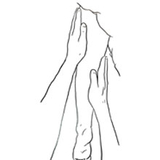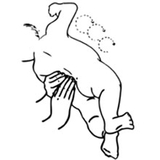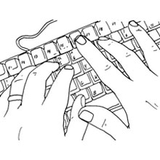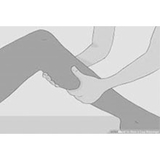Caring Touch Ideas for Parents and Caregivers
Caring Touch Ideas for Parents and Caregivers
Caring Touch is simple massage strokes that you may use to help care for your child while they are hospitalized or at home when they are well. Massaging your child may help them feel cared for and loved. It can help your child develop healthy boundaries, help them relax and build motor skills and brain connections.
How to begin a Caring Touch session:
Ground, relax and focus: This means you are in a calm state of mind and can dedicate some time to focus your attention on your child. You may want to take 3 deep breaths to begin. For more ideas, view our video series on Caring Touch.
Ask permission: Even if you child is unable to talk, ask if they are ready for massage. You may even want to use your hands to communicate. Look for cues that your child is ready to receive massage. Good signs that your child is ready are: making eye contact, a calm state of being, and being interactive. You know your child best. If it seems they are not ready, it is best to wait.
When to avoid massage: If you child has a fever or received vaccinations within the past 72 hours, do not use these techniques. Nurturing Touch is always alright. If you are unsure about massaging your child in certain areas due to lines, wounds, or other healthcare issues, avoid the area and talk to your healthcare provider.
Caring Touch techniques
Nurturing touch

Introduces your touch and pressure on the skin.
Sequence:
- Place both hands gently onto your child with palms touching skin or clothing. The pressure should be light, using only the weight of contact (think feather).
- Remove hands, and reposition the placement, moving from close to further away (proximal to distal)
- Repeat 3 times.
Important considerations:
- For children with sensory issues, a firmer touch may be needed (think light to moderate pressure).
Hand walking

This stroke helps to allow muscles to relax.
Sequence:
- Starting at the top, place hands or fingers (depending on the size of your child or body part) gently walk down the body part alternating left and right.
- Begin to move downward, covering the whole body part.
- Repeat 3 times, starting from the top.
Important considerations:
- Take care around joints.
- Pressure should be gentle but can be adjusted to your child’s preference (think light to moderate pressure).
Gentle circles

This stroke can provide a calming, reassuring effect.
Sequence:
- Starting at the top, use your hands or fingers (depending on the size of your child or body part) to “draw” circles on the body part using gentle pressure.
- Begin to move downward, covering the whole body part.
- Repeat 3 times, starting from the top.
Important considerations:
- If child is ticklish or has sensory issues, a firmer touch may be necessary (think light to moderate pressure).
- The circle can go in any direction.
- Avoid pressure on any bony parts.
Finger tapping technique

This light technique can have a relaxing effect.
Sequence:
- Starting at the top, use your fingertips to tap as though you are typing on a keyboard on the body part using gentle pressure.
- Begin to move downward, covering the whole body part.
- Repeat 3 times, starting from the top.
Important considerations:
- If child is ticklish or has sensory issues, a firmer tap may be necessary (think light to moderate pressure).
Gentle glide

This stroke helps promote circulation and blood flow to the immediate area. This stroke can have a soothing effect similar to a hot shower.
Sequence:
- Starting at the top, use a “C” shape cup with one hand or fingers and thumb (depending on the size of your child or body part) to gently squeeze and glide down the limb. Use the other hand to stabilize and keep the limb from being pulled.
- Begin to move downward, covering the whole body part.
- End with a gentle squeeze.
- Repeat 3 times, starting from the top.
Important considerations:
- Take care around joints.
- Avoid pulling the limb.
- Pressure of squeeze is gentle; however, pressure can be adjusted for your child’s preference (think light to moderate pressure).
Limb rolling

Limb rolling helps to decrease the sensation of pain by stimulating the nerves and tissues. This routine can be used immediately prior to the painful procedure.
This can also be used as a distracting technique when used on the opposite limb that is being used for a painful procedure or needlestick.
Sequence:
- Start at the top of the limb and move down the limb with Nurturing Touch.
- Move back to the top of the limb, position both hands so that they partially encircle the limb with thumbs on top.
- Roll your hands in an outward fashion, one at a time, slowly moving down the limb.
- Repeat 3 times.
- End at the top of the limb with Nurturing Touch.
Important considerations:
- Take care around joints and do not twist. Avoid pulling the limb. Pressure should be gentle however it can be adjusted for your child’s preference (think light to moderate pressure).
Pizza massage
Use your imagination and tell your child a pizza story. Below is a framework to help guide you. You will use some of the techniques described above.
- Wash hands, ask permission. Ask “where do you want pizza on your body?”
- Warm up your hands (rub them quickly back and forth to warm the skin). Pretend you have a ball of dough. Roll the dough and toss in the air!
- Ask questions about which shape pizza and what toppings they want. Place “dough” on back and spread it out using Gentle Glide. Using your palm or fingers, press in a gentle motion out from the center. This is a good time to check in about pressure.
- Using Gentle Circles, add sauce. Ask if they want more sauce or want to go to the next step.
- Add cheese with Finger Tapping Technique. Ask for feedback if they want more or if it’s good.
- Then add 1st topping of choice, tracing the shape.
- Get creative with toppings, they don’t have to be food. You could also build a truck pizza or a Lego pizza.
- Add more toppings as desired.
- Add more cheese.
- Then heat up with Gliding Strokes back and forth on the area.
- When it is warmed up enough, use sides of hands to pretend cut a piece and offer a slice!